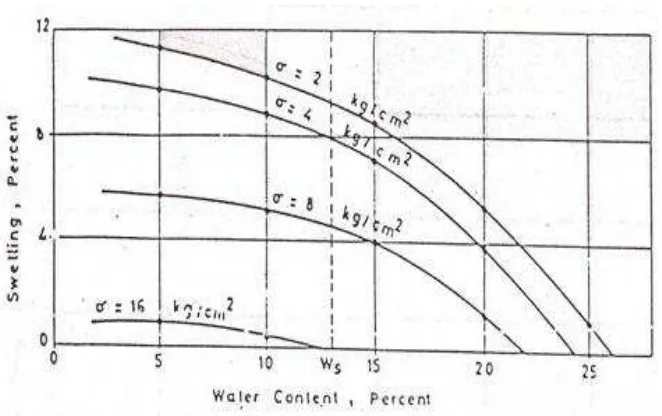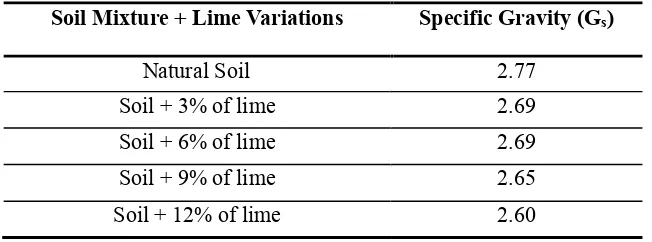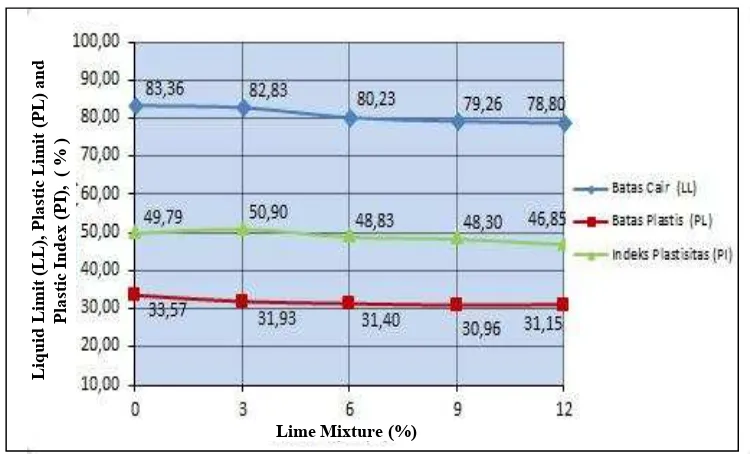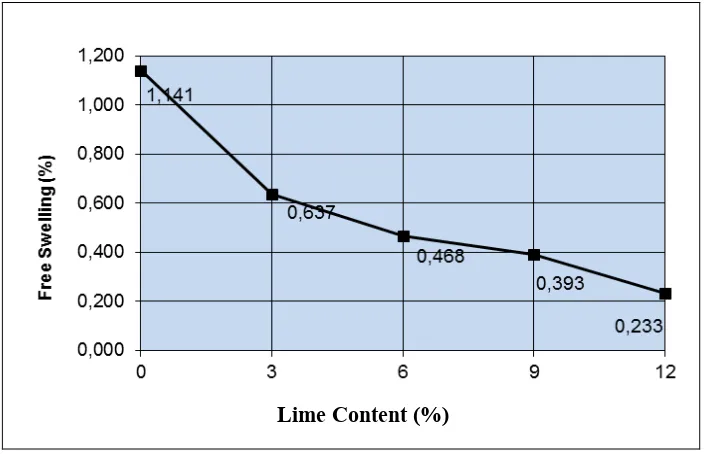Vol. 1, No. 1 (2017): International Journal of Disaster Management - 8
Munirwansyah
1,*, Reza Pahlevi Munirwan
11 Geotechnic laboratory, Civil Engineering Department, Faculty of Engineering,
Syiah Kuala University, Jalan Tgk. Syech Abdurrauf No. 7 Darussalam Banda Aceh, Indonesia
*e-mail: [email protected]
Abstract. This research was conducted for Blang Dalam expansive clay is located in Pidie Jaya-Aceh, Sumatra-Indonesia, which is one of the embankment material used as road subgrade. Road construction use expansive clay soil for subgrade experiencing many damages. The damage of road construction is caused by low bearing capacity when water levels change, high soil plasticity results swelling experience and shrinkage during the rainy and dry season respectively. One method of expansive clay stabilization effort to increase the carrying capacity of the soil is a mixture of Lime Ca (OH)2. Lime mix percentage variation are; 3%, 6%, 9% and 12% of the dry
weight of soil. The purpose of this research is to determine the effect of lime a stabilizing agent to the improvement of the physical and mechanical properties of expansive soil. The result of untreated soil for free swelling is 1.141 % and swelling pressure of 23.18 kPa. For treated soil-lime mixture of 3%, 6%, 9% and 12%, the free swelling value are 0.64 %, 0.47 %, 0.40 % and 0.23 % respectively. Moreover, swelling pressure values for lime variation of 3%, 6%, 9% and 12% are 15.44 kPa, 13.25 kPa, 10.51 kPa, and 9.79 kPa respectively. 12% of soil-lime results shows the most effective results of free swelling which decrease for 1.14% of untreated soil to 0.23% and swelling pressure value of 23.18 kPa for untreated soil decline to 9.79 kPa.
Keywords: Expansive Soil, Free Swelling, Lime Stabilization, Roadway, Swelling Pressure.
1. Introduction
Stabilization for roadway is really depend on subgrade stability which support the main body of road for supporting design load. Subgrade is the bottom (basement) of a highway pavement construction. Subgrade must have a good bearing capacity under the load design and available for long period (design plan).Mitchell, J.K. (1976, 11975), the use of soil as road subgrade must have a certain high strength. Many recent efforts of poor soil (not good subgrade material), poorly graded, high plasticity, soft clay soil is by removing or replace with well graded and good soil. For specific areas of work like material difficulty and overpriced, the replacement soil is difficult to obtaine and even may not be available around. Many losses result of properties of the soil shrinkage. For example like heave on the road, and excessive settlement foundation.
In general, if the soil is more than 50% of deposit containing 0,002 mm particles and smaller is called clay so as in Glee Blang Dalam Bandar Dua, Pidie Jaya-Aceh. This soil is one of the embankment materials and used as road subgrade. Nowadays, this material is commonly used in the road subgrade fill and as a construction material in many villages and housing complexes around Pidie Jaya and Pidie. Currently, due to limited knowledge, and human sources, results this type of soil is starting to be used in National, Provincial and District roads type. Wroth. C.P. (1975), though the type of soil on the site is very sensitive to the effects of moisture content changes and is considered unstable due to the dry state, the soil will be very hard and cracked, while in a wet state, the soil will expand causing the bearing capacity is weak and can damage the road construction on it.
Vol. 1, No. 1 (2017): International Journal of Disaster Management - 9 soil in Glee Blang Dalam that was expected to increase the bearing capacity of the soil or reducing soil swelling, as a result that this soil can be used as roadway subgrade material.
ASCE, (2000), the aims of this study about the behavior of soil stabilization with lime on clay soil in Glee Blang Dalam are:
1. Determine the effect of lime addition for soil shrinkage based on the value swelling expansive soil.
2. To determine the influence of water content acceleration, soil which has expand, the properties of it will affect the value of Free Swelling and Swelling Pressure.
2. Data and Method
Muhardi, et.al (2015), soil stabilization is performed to improvement strength and soil gradation. Stated that a soil must be stabilized if the soil is very loose or poorly graded and easily depressed on the field, or it has an inappropriate consistency index, and its permeability is too high, or other undesirable properties. The stabilization can be done by following actions
1. Increasing the soil density.
2. Adding an inactive material to increase soil shear strength.
3. Addingmaterials to cause chemical and physical changes in the soil. 4. Lowering the soil water level (dewatering)
5. Removed and import material from new borrow area.lacing the poor soil.
2.1 Lime as Soil Stabilization Material and Characteristic of Clay Soil
Ingless and Metcalf, (1992), in implementing the stabilization, the lime that is often used is calcium hydroxide Ca(OH)2. The use of lime as stabilization material can cause a weak ion
exchange of sodium by calcium ions that are on the surface of the clay, so the percentage of fine particles tend to become coarse particles. When the lime reacts with clay minerals, it will form a strong and hard gel that is called silicate calcium that binds the soil grains or particles. Silica gels react by immediately coat and bind clay particles and close the pores of the soil in order to minimize soil plasticity index. Impairment of plasticity index is caused by the increacing of plastic limit value and is accompanied by a decrease in liquid limit.
Ingles, O.G., and Metcalf, J.B., (1972), clay soil can be defined as a collection of mineral particles that has a plasticity index according to the above Atterbergthat when it dries to form a unified mass that required force to separate each microscopic grain. Holtz R.D., and Holm G., (1979)”, microscopic is soil particle that can only be seen by using a microscope, whereas particles that can be seen by eyes directly called macroscopic.
Bowles (1993), stated that clay expansion occurs when the water content increases from the reference. Shrinkage occurs when the water content is reduced from the reference value to the shrinkage limit. Usually a clay soil can be expected to have a large (expansive) volume change if the plasticity index IP ≥ 20.
2.2 Compaction and Swelling Test
Vol. 1, No. 1 (2017): International Journal of Disaster Management - 10
calculated by Equation 2.
V
The moisture content is the ratio between the pore water weight and dry soil grain weight. It is calculated by using Equation 3.
W= x100%
The maximum dry volume weight of soil in optimum water content can be calculated by using Equation 4.
Vol. 1, No. 1 (2017): International Journal of Disaster Management - 11 Figure 1. Effect of Initial Moisture Content of the Swelling Pressure (Source:
McCarthy, D.F., 2002)
The swelling soil testing includes Free-Swelling and Swelling- Pressure. Free Swelling is the soil swelling without load on the top, the soil will be free to swell. Swelling Pressure is pressures arising from the swell are happening so that pressing proving ring. Clay particles contained in a type of soil is very big influence on the nature of the swell of the soil. The relationship between Free Swelling and Swelling Pressure can be seen in Figure 2.
Figure 2. Relations between Free Swelling with Swelling Pressure
Vol. 1, No. 1 (2017): International Journal of Disaster Management - 12 plasticity index IP ≥ 20, with the total of clay fraction (<0.002 mm) that is swelling pressure 23.18 kPa.
Table 1. Data of Physical and Mechanical Properties of Natural Soil Glee Blang Dalam Bandar Dua, Pidie Jaya-Aceh
No. Testing Parameter Results
1 Specific Gravity (gr/cc) 2,77 2 Moisture Content (%) 15,11 3 Atterberg limits
- Liquid Limit (LL,%) - Plastic Limit (PL, %) - Plastic index (PI, %)
83,36 33,57 49,79. 4 Filter Analysis
- Sand(%)
- Silt/Clay (passed # 200, %) - Clay (fraction <0.002 mm, %)
16,26 37,27 46,17 5 Group index
- Silt/Clay (passed # 200, 37,3 %) - Liquid Limit (LL, 83,4 %) - Plastic index (PI, 49,8%)
A-7-6 CH
6 Compaction Test
-Optimum Moisture Content%
- Maximum Dry Density (gr/cm3) 31,08 1,32
7 Swelling test
-Free Swelling (%)
- Swelling Pressure (kPa) 23,18 1,14
3. The Results of Stabilized Soil by Lime
The testing results of soil physical and mechanical properties variations with a mixture of lime can be seen in Table 2. Variation soil mixture showed a concomitant decrease with the increase of lime mixture percentage.
Table 2. Results of the Soil Specific Gravity with a Mixture of Lime Variation
Soil Mixture + Lime Variations Specific Gravity (Gs)
Natural Soil 2.77 Soil + 3% of lime 2.69 Soil + 6% of lime 2.69 Soil + 9% of lime 2.65 Soil + 12% of lime 2.60
Vol. 1, No. 1 (2017): International Journal of Disaster Management - 13 it can be seen that the distribution of grain retained in the sieve no.10 to no. 200 has increased, while the distribution of soil grain that passes sieve no. 10 to no. 200 decreased from the original soil.
Table 3. The Testing Results of Soil Sieve Analysis by adding lime mixture
Sieve
No. Soil mixture + Lime variations
Natural decrease while the plastic limit tended to increase. Thus, the plasticity index tended to decrease with increasing the lime percentage.
Table 4.The Testing Results of Soil Atterberg Limits by Lime Mixture Variations
No Soil Mixture + Lime
Variations Atterberg Limits (%)
Liquid Limit
Vol. 1, No. 1 (2017): International Journal of Disaster Management - 14 Table 5. Group Index(GI) and Soil Classification System
No Soil Mixture +
LimeVariations Group Index GI) (%) Soil Groups According to Classification System
AASHTO USCS optimum moisture content (OMC) value will decrease.
Table 6. Results of Compaction Testing
No Soil Mixture + LimeVariations Parameterof Compaction
Maximum
The decline Free Swelling occurs along with the addition of lime each of the various a mixture of lime as show in Figure 7, where the mixture of lime 3% variation experienced a significant decrease of 1.141% on natural soil became 0.637% on a mixture of 3%, while in another variation, a relative decline little.
Tabel 7. Results of Free Swelling
Vol. 1, No. 1 (2017): International Journal of Disaster Management - 15 As show in Table 8, described decrease in swelling pressure occurs along with the addition of lime each variation of a mixture of lime, where the mixture of lime 3% variation experienced a significant decrease of 23.18 kPa on natural soil became 15.44 kPa on a mixture of 3%, while in another variation, relative decline little.
Tabel 8. Results of Swelling Pressure related Soil-Lime Mixture
No. Soil Mixture + LimeVariations Swelling Pressure (kPa)
The results of the research, clay soil in Glee Blang dalam, Pidie Jaya district has a dark brown reddish color, it is clay and sticky when held by hand. Moreover, in the dry condition, the soil is very hard and strong while in the wet condition, the soil is weak and fluffy, so that the soil can be said clays. From the results of the physical properties and classification of the original clay in this soil, according to AASHTO, it is classified into groups A-7-5 (argillaceous) and according to USCS, it is classified into high plasticity anorganic clay and fat clays (CH).
4.1 Effect of lime mixture on physical properties of clay soil
Wesley, L.D., (1977), stated that a mixture of soil and lime will produce a solution that adheres the particles, the existing pore cavities will partly surrounded by the harder sedimentation material and more difficult to penetrate the water. Pore cavity isolated by impermeable sedimentation layers will be measured as the volume of grain, thus increases the volume of grain and reduces of soil types subsequently. The addition of lime percentage to some extent will increase the pore cavities that are trapped in sedimentation layers and will decrease the specific gravity of the mixture. Sieving analysis test, dry sieving and wet sieving (hydrometer) analysis, was conducted, we found the natural soil clay content of 30.96%. Testing of particle-size distribution, especially in the tendency of changes in the fraction value <0.002 mm, it could determine changes in the properties of the soil mixture. The test results showed that the addition of lime percentage will decrease the percentage of the fraction <0.002 mm, it suggested that the binding of the lime to fine particles become greater
.
Vol. 1, No. 1 (2017): International Journal of Disaster Management - 16
Figure 3. Correlation between Liquid Limit and Plastic Limit by the Addition of Lime
To determine the quality of the natural soil or its mixture with lime, first, it was determined its group index by using the equation, GI = (F - 35) [0.2 + 0.005 (LL - 40)] + 0.01 (F - 15) (PI - 10), so we obtained the group indexes according to ASSHTO system as shown in Table 5. From the table, it shows no changes in the naturall soil group due to lime used as a mixture in the form of grains was smooth gradation so unnoticeable on the distribution of grains. Also by using USCS classification system, it did not change the natural soil group, due to the amount of lime used as a mixture in the form of fine grains that were not too noticeable on the distribution of grain after it was mixed.
4.2. Effect of Lime Mixture on Clay toward Compaction
Soil compaction test results are as shown in Table 6, the maximum dry weight showed an increase while the optimum moisture content (OMC) decrease with increasing of lime mixture. This is because the lime mixed in the soil can increase the holding capacity or increasing inter-granular holding ability among the grains. In addition existing pore cavities, it will be partially surrounded by harder cementation thereby reducing clay particle that binds water, so the moisture content in the soil will decrease.
From the results, it can be described that the more the addition of lime to clay soil, the less percentage of grains, and clay particles that react with water getting fewer. Thus, the moisture content needed to solidify the soil decreases with increasing of lime percentage. At the optimum moisture content, water can have a function as a lubricant so that the composition of the grain is better, the grain filling each content, easily solidified which will increase the soil density.
4.3. The influence of a mixture of lime on clay the value of Glee BlangDalam Free Swelling and Swelling Pressure
As shown in Figure 4 and Figure 5, shows the tendency decline in value Free Swelling along with the addition of lime. Decrease Free Swelling and Swelling Pressure occurrence due to the addition of lime, this lime causing clots that can enhance inter-grain belt. The increased bond
Lime Mixture (%)
Liquid Limit (LL), Plastic Limit (PL) and
Vol. 1, No. 1 (2017): International Journal of Disaster Management - 17 between grains, it will improve the ability to interlock between the granules. In addition, the existing pore voids will partially surrounded cementation material is harder, so that the grain is not easily broken or deformed by the influence of water.
Figure 4. The Connection of Value Free Swelling with Lime Addition
This is because the lime is mixed in the soil Glee Blang Dalamcan increase the holding capacity to minimize inter-granular and voids and moisture content also decreases.Decrease Free Swelling and Swelling Pressure is influenced by the density of the soil, can be interpreted by the increasing density of the swelling value will also decrease.
Figure 5. The Correlation of Swelling Pressure with the Addition of Lime
Lime Content (%)
Vol. 1, No. 1 (2017): International Journal of Disaster Management - 18
5. Conclusions
The results of this research can be concluded:
1. The classification of the natural clay soil, according to AASHTO it is classified into groups A-7-5 and according to USCS, it is included into high plasticity unorganic clay and fat clays (CH).
2. The results of Atteberg limits testing from soil mixed with the lime showed a decrease in soil plasticity index. The decrease was shown by the results of the liquid limit test of 83,36 % decreased to 78,80 % in the lime percentage of 12%.
3. The results of plastic limit test of 33,57% decreased to 31,15 % in the lime percentage of 12 %. Thus.
4. The plasticity index decreased from 49,79 % to 46,85 % in the lime percentage of 12 %.
5. On the lime percentage addition from 3% to 12% , the Swelling pressure increased depend on water absorb increased.
6. Index plasticity of soil is reduce as also free swelling and swelling pressure will be decreased.
7. Soil material from Gle Bang Dalam, Pidie Jaya District, is cannot be used as construction material like for highway, bridge, runway.
Acknowledgement
The authors would like to thanks their respective universities, Geotechnics and Soil Mechanics Laboratory staff and assistance of Syiah Kuala University, and Mr. Naziruddin, for assistance during this work.
References
ASCE, (2000). Soil Sampling, Technical Engineering and Design Guides, as Adapted from the US. Army Corps of Engineers, No. 30.
Bowles, J. E., (1993). Phisical Properties and Geotechnic (Soil Mechanics), translate by Hainim, J.K., Erlangga, Jakarta.
Herlinawaty, Rifa A. and Suryolelono, K.K., (2016). The Influence of Water Content and Matric Suction Value in Identification of Parth Saturated Soil Parameter”, Proceeding 11th Indonesian
Geotechnical Conference and 20th Annual Scientific Meeting, Geotechnical Role to Accelated
Infrastructure Construction in Indonesia”, ISBN No. 978-602-17221-4-5, Jakarta, pp. 275-282.
Holtz R.D., and Kovacs W.D., (1981). An Introduction To Geotechnical Engineering, Prentice Hall Civil Engineering Mechanics Series, Prentice Hall, Inc., Englewood Cliffs, New Jersey 07632, pp. 163.
Holtz R.D., and Kovacs W.D., (1980). SI Units in Geotechnical Engineering, Geotechnical Testing Journal, ASTM, Vol. 3, No. 2.
Vol. 1, No. 1 (2017): International Journal of Disaster Management - 19 England, Vol. 3, pp. 79-86.
Ingles, O.G., and Metcalf, J.B., (1972). Soil Stabilization Principles and Practice, Australia: Butter Worths, Brisbane.
Muhardi, Kusniawandy A., and Purmadona S., (2015). Low Plastcity Index Soil Stabilization by Using Cement, Proceeding 10th Indonesian Geotechnical Conference and 19th Annual
Scientific Meeting, Geotechnical Role in Mega Structure Construction” , ISBN No. 978-602-17221-3-6, Jakarta, pp. 245-250.
Mc Carthy, D.F., (2002). Essentials of Soil Mechanics and Foundations, Basic Geotechnics, Sixth Edition, Prentice Hall International (UK) Limited, London, pp. 104-134.
Mitchell, J.K., and Gardner, W.S., (1975). In Situ Measurement of Volume Change Characteristic, State of the art, Proceedings of the ASCE specialy conference an in situ measurement of soil properties, Reileght, Nort Carolina, Vol II, p. 333.
Mitchell, J.K. (1976). Fundamental of Soil Behavior, John Willey & Sons, Inc., New York, p. 422.
Proctor, RR., (1933). Fundamental Principles of Soil Compaction, Engineering News-Record, Vol.111, Nos. 9, 10, 12 and 13.
Wesley, L.D., (1977). Soil Mechanics, 6th edition , Badan Penerbit Pekerjaan Umum, Jakarta.
Wroth. C.P. (1975). In Situ Measurement of Initial Stresses and Deformation Characteristics,
Proceeding of The ASCE Spescially Conference on In Citu Measurement of Soil Properties, Releygh, Nort Carolina, Vol II, pp. 181-230.
Wroth. C.P. (1972). In General Theories of Earts Pressure and Deformations”, General Reeport,






